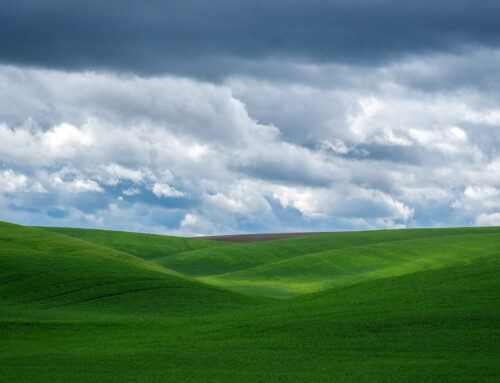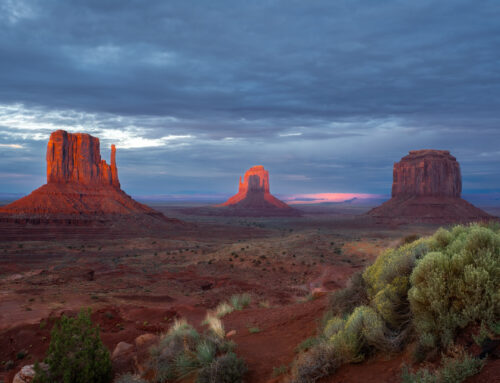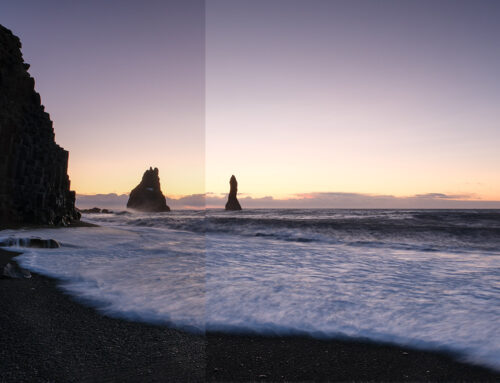I’ve started a new series on my YouTube channel called Which One Works. In these short videos I discuss my own photographs and walk you through which composition works, or doesn’t work, and why I think that way. I’m trying to keep these videos short, like 5-6 minutes, and informational so you can hear a bit of why I think one image might be more successful than another. Which one works can be a bit of a misnomer since both images may technically “work”, but oftentimes it comes down to the small details, the nuance as well as personal preference which one I like best. If you’ve ever been on one of my workshops and we’ve done an image review, this is a lot like those image reviews…just with my own images.
We are often drawn to certain scenes when on location, something about the subject, light or other elements draw us to set down our tripod and begin composing a shot. As we work the scene, trying to create the best composition possible, we may take different compositions. In fact, I hope you all take different compositions in the same location, refining and creating slightly different versions. Then, when you get back home and download the images, it’s time to go through them and decide which one works best for you and what you hoped to accomplish in the scene.
Which one works for you is the step beyond the initial culling of images, discarding the obviously bad, technically inferior shots. What is left are those images that are technically sound, visually pleasing and worthy contenders for further post processing. What I’ve also found over the years that is an image may be technically sound but not make a strong initial impression on me when I first review the fresh shots, but over time, it grows on me sometimes becoming one of the strongest shots of the shoot. This has proven to me that initially something might not work aesthetically or artistically for me, but as I grow as an artist or the emotion of the shoot disputes, I can view the image with fresh eyes.
OK, so you’ve got a folder full of great shots of a particular scene, how do you pick which one works? Unfortunately, there is no one right answer for this. So much depends on the scene, the environmental conditions and the light to know which exactly is the “best” shot from the group. And, a HUGE portion of which one works for me is how closely does the photograph capture the artistic inspiration in the field, how much of the emotion that I felt does it capture and does it tell the “story” I want it to tell? More subtler evaluations I do are around how the subject is portrayed in the composition, does it stand out as much as I want. Or, did I miss seeing something in the field, like a visual impediment or other obstruction that interrupts the flow or feeling. How about the “visual weight” of different elements in the photograph, does it “feel” right for what I was trying to achieve. All of these things go in to helping me decide which one works.
In this video series, my goal is to share what is going on in my head, how I look at my own images and then make a decision which one to go ahead and process from a scene. When I’m in the field, I will shoot a scene with slight adjustments in positioning, focal length, shutter speed and depth of field, among some of the most common adjustments I’ll make. For these videos, I will choose two or three slightly different images from one particular scene and then walk you through my mental process and my evaluation of each of them until I arrive at the image that I feel works the best.
In this first episode, I take a look at a couple of images I shot recently at Bandon Beach, leading a workshop there in October. We were treated to some amazing light one night before the actual sunset and my eye was drawn to some ripples in the sand. I shot several different versions of the scene and chose two of them to talk you though which one works for me.
Another shot from Bandon beach during the same workshop, in this video I’m talking about the position of the “face” in the composition plus the visual weight of the large sea stack. Although both images have their flaws, I walk you though my decision process which one works better than the other.
I hope to add regularly to the Which One Works series so please subscribe to my YouTube channel so you don’t miss any episodes of this. I’ve got two more episodes in the works to release in the coming weeks! There are a lot of great folks teaching technical information about “how” to do something…I am more passionate about “why” to do something, more focused on the artistic side of photography along with the subtleties of what can take a good image and make it great!





Leave A Comment